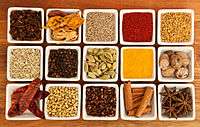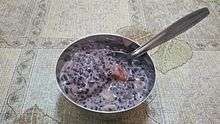Manipuri cuisine
Manipuri cuisine is usually represented by the traditional cuisine of the Meiteis, an ethnic majority of Manipur, a state of North Eastern India. Daily meals are based on rice, with a few side dishes of vegetables and fish. A meal would usually have a vegetable stew called ensaang or athongba, flavored with dried or fried fish; stir-fried vegetables called kanghou; and a spicy item, which could be morok metpa (a chilli paste), iromba (boiled and mashed vegetables with chilli and fermented fish), or singju (a piquant salad). All piquant side dishes are accompanied by a choice of fresh herbs, collectively called maroi. The base and essence of Meitei cuisine is the fermented fish called ngari.
A side of steamed (a-ngaanba) or boiled vegetables with a hint of sugar (cham-phut) are also quite common as palate cleansers in most meals. The aromatics of most dishes start with frying bay leaf, chives, onion, garlic, and ginger in mustard oil. The rest of the vegetables follow after that. Oil is sparingly used in most of the main stews but the sides of kanghou (stir-fried spicy vegetables) and bora (fritters) make up for that. Fish is also a staple, and appears in every meal, either as ngaari or as roasted or fried pieces. While fish is an essential part of the diet, due to increasing prices, fish curry is prepared only occasionally, or during feasts. The Meiteis live in the valley of Manipur where freshwater fish from lakes and rivers and ponds had been plentiful until recent times. While part of the cuisine has some influences from the cuisines of Southeast Asia, East Asia, Central Asia, Siberia, Micronesia, Polynesia as well as from Assam and West Bengal, the essence remains distinct from any other.
 |
| This article is part of the series on |
| Indian cuisine |
|---|
|
Regional cuisines
|
|
Ingredients, types of food
|
|
See also
|
|
Related cuisines |
|
Basic diet
The staple diet of Manipur consists of rice, fish, large varieties of leafy vegetables (of both aquatic and terrestrial).[1] Manipuris typically raise vegetables in a kitchen garden and rear fishes in small ponds around their house. Since the vegetables are either grown at home or obtained from local market, the cuisines are very seasonal, each season having its own special vegetables and preparations. The taste is very different from other Indian cuisines because of the use of various aromatic herbs and roots that are peculiar to the region and list of these aromatic herbs and roots are listed below.[2]
Aromatic herbs and roots used by the Manipuris
- Nungshi hidak (Mint)
- Maroi napaakpi (Hooker chives)
- Maroi naakuppi (Chinese chives)
- Awaa phadigom (Mexican coriander)
- Mayang-ton (Lemon Basil)
- Toning-khok (Chameleon plant)
- Khanghuman / Kanghu-maan (Meriandra dianthera,[3] formerly Meriandra bengalensis)
- Mukthrubi (Zanthoxylum armatum[3] / Sichuan peppercorn)
- Phakpai (Vietnamese coriander)
- Chantruk (pepper cress)
- Yaipan (Curcuma angustifolia[3])
- Kang-hu mapaan
- Takhel-manao
- Nongmangkha-mapan
- Leipung-khang (Solanum anguivi[4])
Further, many large varieties of the vegetables that are used in daily meals are found only in and around the region and not seen elsewhere. Some of these are as follows:
- Yendem (a kind of Indian taro)
- Hangam Pere (mustard big leaf)
- Kobi (Cabbage)
- Hangam angouba (lettuce)
- Chawai
- Hawai manaa
- Koukhaa (Arrowhead or Katniss)
- Kakthrum
- Loklei
- kengoi
- Punlei
- Kolamni (Water spinach)
- Peruk (Centella)
- Yelaang (Jointweed)
- Kengoi
- Phunin
- Yensil (Creeping woodsorrel)
- Thaanjing (Foxnut)
- Yongchaak (Parkia javanica/Stink bean or Bitter bean)
- Yaipan (East Indian Arrowroot)
- khang-mana
- Komprek (Japanese parsley)
- Hei-ba mana
- Yendung
- Chengkhruk
- Tengnou-Maanbi (winged bean)
- Ookhajing
- Ikaithabi
- Sougri (Roselle Leaves)
Various kind of mushrooms also form an important part of the cuisines. These include:
- Thangjiyen
- leibakmaroom
- Uyen (similar to shiitake mushroom)
- Uchi-na (Jelly ear)
- Chengum (Mushroom)
- charu-yen
- Kanglayen (Split gill mushroom),
- Ushoi (Bamboo Shoots), etc.
There are also ingredients in the cuisine that require an acquired taste, such as Hawaijaar (fermented soya bean, somewhat similar to the Japanese Natto), Soibum (fermented bamboo shoot) and Ngaa-ri (fermented fish).
Simple dishes

Eromba is a chutney that have vegetables boiled or steamed with a lot of red chillies or umorok (king chilli) with ngari (fermented fish), smoked or roasted fish and mashed together. "U-morok" – literally ‘tree chilli’ u = tree; morok = chilli. It is garnished with herbs like maroi ( maroi nakuppi, phakpai, mayang-ton, toning-khok, kaanghumaan, lomba, tilhou, chaantruk, coriander leaves and many more).
Singju is a salad which may be prepared with finely chopped banana stem, laphu tharo (banana flower), cabbage, lotus stem, komprek (a kind of scented herb), kollamni (another herb), tree beans, coriander leaves, sinju pan, ginger, heibi mana and many seasonal vegetables mixed with ngari. Boiled kidney beans are optional and the dish is seasoned with red chilli flakes, salt to taste, with roasted sesame powder and roasted chick pea powder.
Chamthong or Kangshoi is a stew of any seasonal vegetables with coarsely chopped onions or spring onion, maroi - both yennam nakuppi and napakpi, ginger, ngari and salt, topped with ngari,[5] dried fish, or fried fish pieces and water. It is soupy in consistency and is eaten with rice.
Morok metpa is a coarse paste prepared with green or dry red chilies mixed with chopped onions, coriander leaves and other local herbs for garnishing. The chilies are steamed or roasted with ngari[5] or simply crushed and then mashed with salt and ngari; fried fish pieces can also be added to it. This is something which accompanies both the meals as a routine side dish.
Other dishes include kang-ngou or kaang-hou (various vegetables stir fried with traditional spices), nganam (prepared with fish and maroi on a pan) or paaknam (sort of a pancake prepared with a mixture of pea flour, maroi napaakpi, laphu tharo, awa phadigom, and ngari wrapped in turmeric and banana leaves and baked in a pan or steam it first and then roasted it for sometime), nga-thongba (fish curry), ooti (a typical Manipuri vegetarian dish), pakoura thongba, chagem pomba (made with fermented soya, mustard leaves, roasted or smoked fish and other herbs), keli chana, alu kangmet (boiled potato mashed with fried red chilli and nakuppi with salt and/or dressed with mustard oil), sana thongba which is prepared with paneer in Manipuri style, a-nganba (steamed vegetables, such as pumpkin, peas, carrots, French beans, etc.).
References
- "Cuisines of North East India".
- "some fruits and foods of Manipur". Archived from the original on 10 July 2011.
- "Flowers of India".
- "AgriManipur". 2 (1). October 2012. Cite journal requires
|journal=(help) - "Ngari". Leirang - the culinary journey. 18 February 2010. Archived from the original on 9 June 2010.